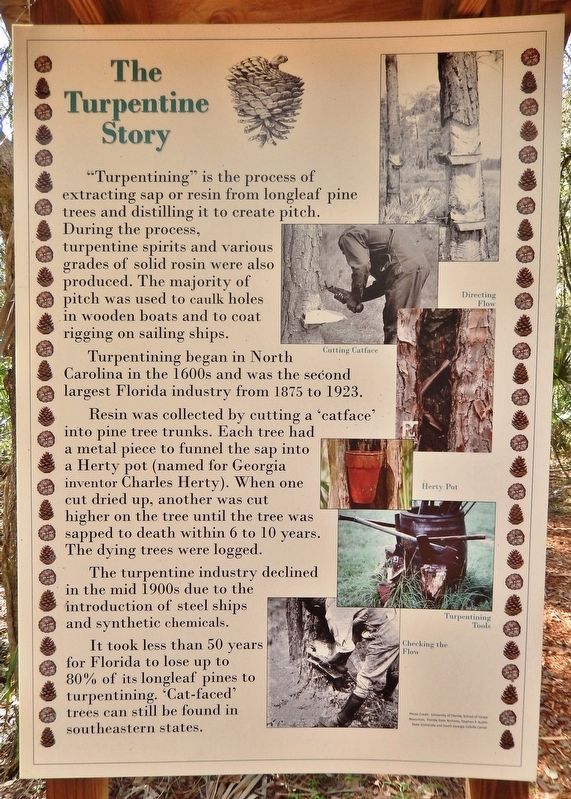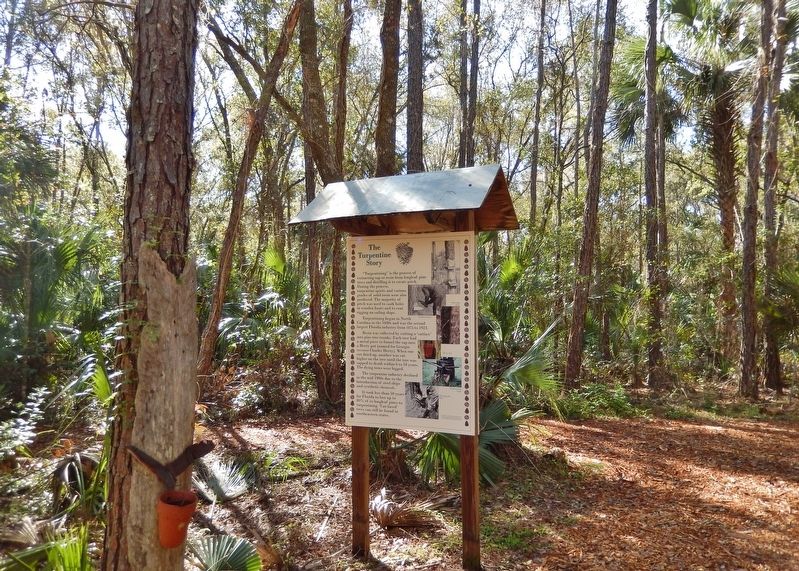Eustis in Lake County, Florida — The American South (South Atlantic)
The Turpentine Story
"Turpentining" is the process of extracting sap or resin from longleaf pine trees and distilling it to create pitch. During the process, turpentine spirits and various grades of solid rosin were also produced. The majority of pitch was used to caulk holes in wooden boats and to coat rigging on sailing ships.
Turpentining began in North Carolina in the 1600s and was the second largest Florida industry from 1875 to 1923.
Resin was collected by cutting a 'catface' into pine tree trunks. Each tree had a metal piece to funnel the sap into a Herty pot (named for Georgia inventor Charles Herty). When one cut dried up, another was cut higher on the tree until the tree was sapped to death within 6 to 10 years. The dying trees were logged.
The turpentine industry declined in the mid 1900s due to the introduction of steel ships and synthetic chemicals.
It took less than 50 years for Florida to lose up to 80% of its longleaf pines to turpentining. 'Cat-faced' trees can still be found in southeastern states.
[photo captions]
• Cutting Catface
• Directing Flow
• Herty Pot
• Turpentining Tools
• Checking the Flow
Topics. This historical marker is listed in these topic lists: Horticulture & Forestry • Industry & Commerce. A significant historical year for this entry is 1875.
Location. 28° 52.327′ N, 81° 40.895′ W. Marker is in Eustis, Florida, in Lake County. Marker can be reached from County Road 44, 0.4 miles east of State Route 19, on the right when traveling east. Marker is located near the north end of the Lazy Oak Trail at Trout Lake Nature Center. Touch for map. Marker is at or near this postal address: 520 East County Road 44, Eustis FL 32726, United States of America. Touch for directions.
Other nearby markers. At least 8 other markers are within 2 miles of this marker, measured as the crow flies. The Turpentine Process (here, next to this marker); The Clifford House (approx. one mile away); Captain David M. Walker (approx. one mile away); a different marker also named Clifford House (approx. one mile away); On The Waterfront (approx. one mile away); Entrance Names (approx. 1.1 miles away); The Pavilion (approx. 1.1 miles away); Boat Works (approx. 1.1 miles away). Touch for a list and map of all markers in Eustis.
Related markers. Click here for a list of markers that are related to this marker.
Also see . . .
1. The Brutality of Florida's Turpentine Industry.
Starting in the coastal mid-Atlantic region in the mid-1800s, turpentine camps would move south as entire forests of pine worked, leaving the trees with little to no sap production. By the late 1800s, turpentine production camps had reached pine stands of northern Florida. The industry was booming between the late 1800s and 1920s, and camps were established throughout pine forests in North Central Florida. After the 1920s camps began to close in favor of timber harvesting.(Submitted on January 6, 2023.)
2. The Turpentine History in Florida.
The turpentine industry began to boom alongside the naval supply stores that used their products and the vast pine forests of North Florida were a lucrative ground for harvesting gum sap to make turpentine. Between the 1920s and 30s, hundreds of turpentine camps popped up on the Florida maps to house workers who came to harvest the pine gum. They would cut ‘cat faces’ into the trees where small buckets would gather the pine gum that came from the cuts.(Submitted on January 6, 2023, by Cosmos Mariner of Cape Canaveral, Florida.)
Credits. This page was last revised on January 6, 2023. It was originally submitted on January 6, 2023, by Cosmos Mariner of Cape Canaveral, Florida. This page has been viewed 793 times since then and 407 times this year. Photos: 1, 2. submitted on January 6, 2023, by Cosmos Mariner of Cape Canaveral, Florida.

